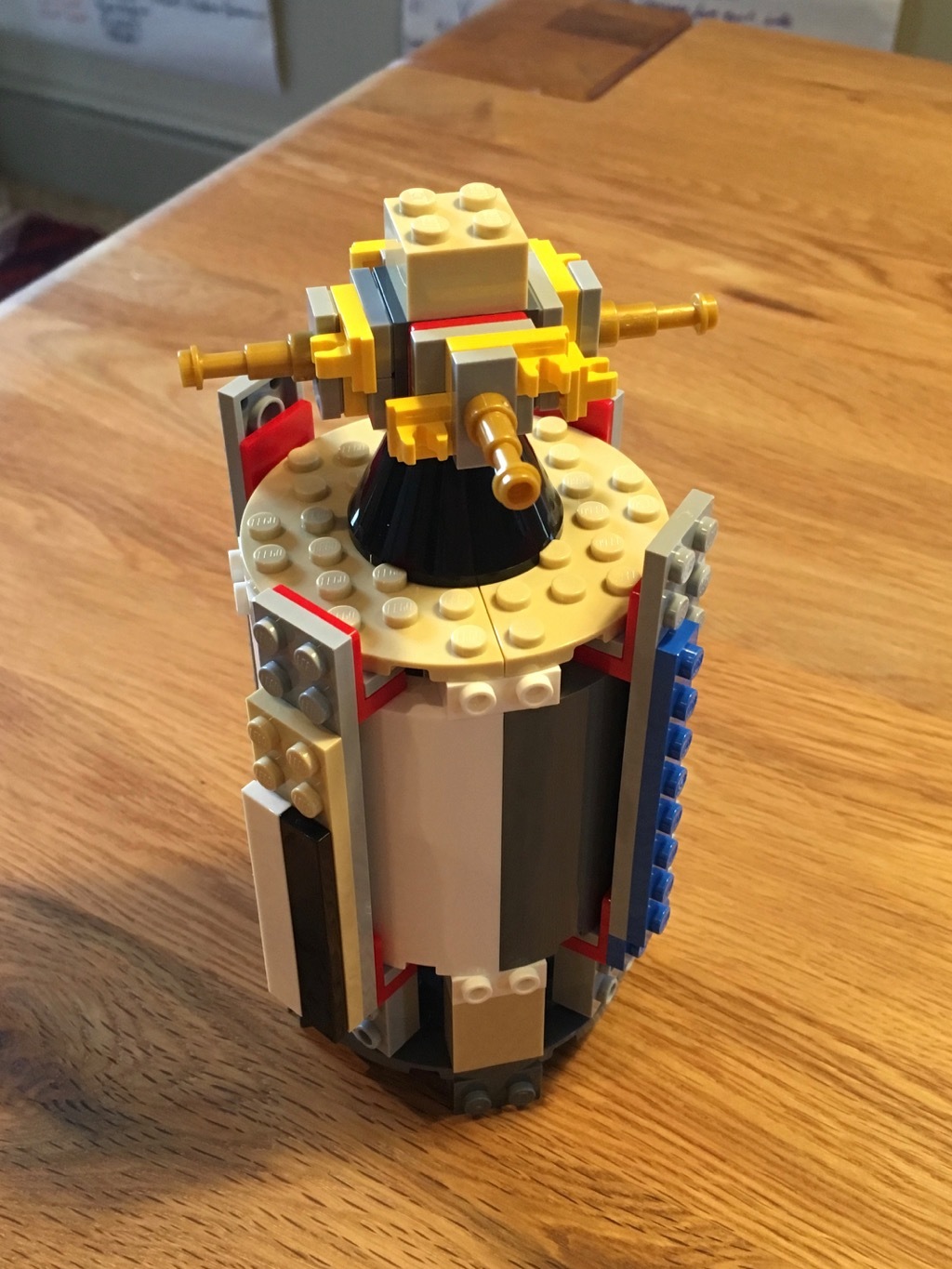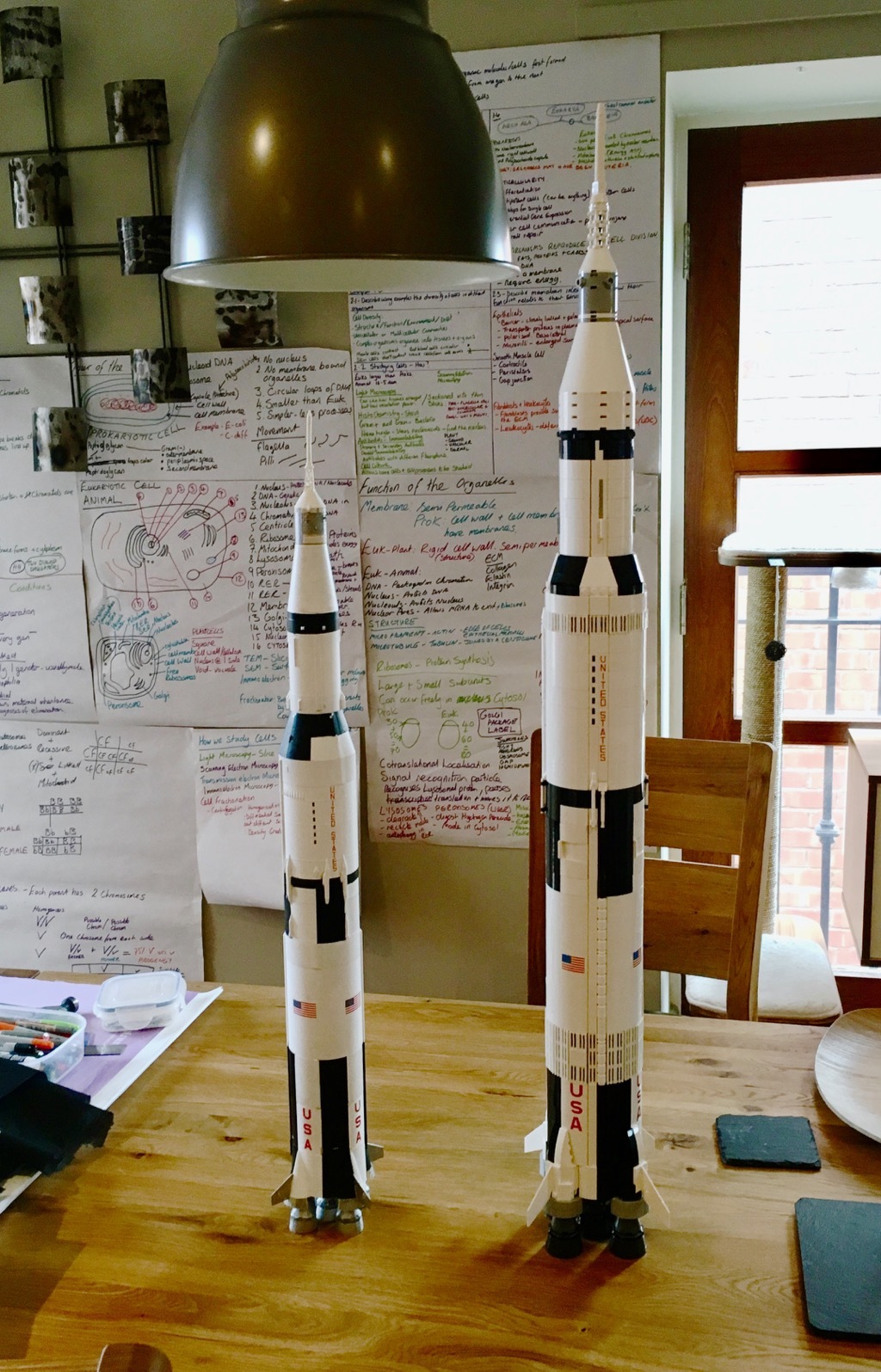Simon Bradshaw (![[personal profile]](https://www.dreamwidth.org/img/silk/identity/user.png) major_clanger) wrote2017-05-29 09:44 am
major_clanger) wrote2017-05-29 09:44 am
Lego - Saturn V!
Last year Lego picked, as one of its fan-suggested kits, the Apollo Saturn V moon rocket. About a month ago details of the final kit emerged, with a launch (ahem) date of 1st June. Then on Friday a friend mentioned over on Facebook that John Lewis had the kit in stock early. I checked and there it was, with the option of next-day pickup in our local branch. The decision to order took, I don't know, about 5 milliseconds, and on Saturday afternoon we popped in to pick up what proved to be an impressively large box.

Yes, I was rather pleased to get this. Arthur C Clarke once said that happiness is a childhood dream achieved as an adult (he ascribed this to Freud, but I can't find any citation.)

Inside the box are twelve bags and a nicely-done manual, which is mercifully a lot thinner than the one for the Ghostbusters Firehouse we built over the New Year. Bags 1-6 build the S-IC first stage, bags 7-10 the S-II second stage, bag 11 the S-IVB third stage and Bag 12 builds the Command and Service Module (CSM), Lunar Module (LM), LM shroud, escape tower, and little dioramas of the lunar landing and splashdown.

This is the first stage, early on. The build is very complex, as you're trying to make a cylinder, which isn't something Lego readily lends itself to except in a few standard sizes, all of which are too small for this kit. You do actually start by building a cylindrical core, but it's just the backbone that various elements are attached to.

Lots of red, white and black, very evocative of 1960s NASA colour schemes.

A lot of Lego kits use stickers for fine details, which can be fiddly to apply. The Saturn V has all-printed parts where surface detail is important, which goes a long way towards the high standard of appearance of the final model.

Much of the build is quite repetitive, making two or four copies of a subassembly. The kit features a lot of little 1x2 grids to represent the ridged stringer sections of the real rocket.

The first stage, mostly done. One of the odd aspects of the kit is that in contrast to the black/white/red exterior, the inner structure is very brightly coloured. I assume this is a deliberate decision to make it easier to follow building instructions in terms of seeing which bit goes where. It does look rather odd during the build though.
(In case you're wondering about the background,![[personal profile]](https://www.dreamwidth.org/img/silk/identity/user.png) attimes_bracing is in the middle of her OU cell biology revision.)
attimes_bracing is in the middle of her OU cell biology revision.)

The completed first stage. It was at this point it came home to me just how big the full model was going to be.

The second stage, again showing the complicated internal structure. This is in part to support the various details around the top of the stage, and in part to provide a firm mount for the clips that hold the stages together.


Stage 2 continues to come together.

...and complete. The model does struggle a bit to depict the S-II / S-IVB interstage, which in scale was a bit taller, and also had a rather more complex paint pattern that was use to help photographic tracking during flight. I can see that it would have been fiddly to get that exactly right, and would probably have involved resorting to stickers.

The third stage coming together.

CSM and escape tower. During launch the CM was covered with a protective conical shroud, hence the absence of any detail. (Technically, there could have been a hatch outline and small window, but I can see why Lego didn't go that far.)

Lunar landing diorama. The figures are in scale, so much smaller than normal minifigs. You get 4 including a spare, although of course only 2 went down to the lunar surface.

Splashdown! Again, lovely attention to detail, with the righting balloons and external flotation collar.

A few years ago I built the Airfix 1:144 Saturn V. I've long thought that a big model, but the Lego one is visibly larger. It is also far heavier, tipping the scales at 1.6kg rather than the 310g of the Airfix kit. (By the way, my Airfix model is actually wrong in one detail - I painted the first stage stripes too far up. The Lego kit is right!)

The kit comes with some little trestles you can put together to support the rocket horizontally, either in one piece or with the stages separate (like the surviving Saturn Vs at Cape Canaveral, Houston and Huntsville.) If anything, it looks even bigger seen like this.

OK. the orange glow in the engines is a bit of artistic licence, but the detail of the F-1 engines themselves is very good, down to the turbopump exhaust manifold that wrapped around the engine nozzle.

I now have my own not-so-little Saturn V historical display :-)

Yes, I was rather pleased to get this. Arthur C Clarke once said that happiness is a childhood dream achieved as an adult (he ascribed this to Freud, but I can't find any citation.)

Inside the box are twelve bags and a nicely-done manual, which is mercifully a lot thinner than the one for the Ghostbusters Firehouse we built over the New Year. Bags 1-6 build the S-IC first stage, bags 7-10 the S-II second stage, bag 11 the S-IVB third stage and Bag 12 builds the Command and Service Module (CSM), Lunar Module (LM), LM shroud, escape tower, and little dioramas of the lunar landing and splashdown.

This is the first stage, early on. The build is very complex, as you're trying to make a cylinder, which isn't something Lego readily lends itself to except in a few standard sizes, all of which are too small for this kit. You do actually start by building a cylindrical core, but it's just the backbone that various elements are attached to.

Lots of red, white and black, very evocative of 1960s NASA colour schemes.

A lot of Lego kits use stickers for fine details, which can be fiddly to apply. The Saturn V has all-printed parts where surface detail is important, which goes a long way towards the high standard of appearance of the final model.

Much of the build is quite repetitive, making two or four copies of a subassembly. The kit features a lot of little 1x2 grids to represent the ridged stringer sections of the real rocket.

The first stage, mostly done. One of the odd aspects of the kit is that in contrast to the black/white/red exterior, the inner structure is very brightly coloured. I assume this is a deliberate decision to make it easier to follow building instructions in terms of seeing which bit goes where. It does look rather odd during the build though.
(In case you're wondering about the background,

The completed first stage. It was at this point it came home to me just how big the full model was going to be.

The second stage, again showing the complicated internal structure. This is in part to support the various details around the top of the stage, and in part to provide a firm mount for the clips that hold the stages together.


Stage 2 continues to come together.

...and complete. The model does struggle a bit to depict the S-II / S-IVB interstage, which in scale was a bit taller, and also had a rather more complex paint pattern that was use to help photographic tracking during flight. I can see that it would have been fiddly to get that exactly right, and would probably have involved resorting to stickers.

The third stage coming together.

CSM and escape tower. During launch the CM was covered with a protective conical shroud, hence the absence of any detail. (Technically, there could have been a hatch outline and small window, but I can see why Lego didn't go that far.)

Lunar landing diorama. The figures are in scale, so much smaller than normal minifigs. You get 4 including a spare, although of course only 2 went down to the lunar surface.

Splashdown! Again, lovely attention to detail, with the righting balloons and external flotation collar.

A few years ago I built the Airfix 1:144 Saturn V. I've long thought that a big model, but the Lego one is visibly larger. It is also far heavier, tipping the scales at 1.6kg rather than the 310g of the Airfix kit. (By the way, my Airfix model is actually wrong in one detail - I painted the first stage stripes too far up. The Lego kit is right!)

The kit comes with some little trestles you can put together to support the rocket horizontally, either in one piece or with the stages separate (like the surviving Saturn Vs at Cape Canaveral, Houston and Huntsville.) If anything, it looks even bigger seen like this.

OK. the orange glow in the engines is a bit of artistic licence, but the detail of the F-1 engines themselves is very good, down to the turbopump exhaust manifold that wrapped around the engine nozzle.

I now have my own not-so-little Saturn V historical display :-)
no subject
no subject
no subject
no subject
no subject